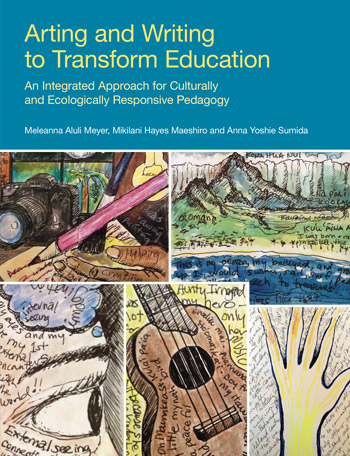
Arting and Writing to Transform Education - An Integrated Approach for Culturally and Ecologically Responsive Pedagogy - Meleanna Meyer
Appendix F: Sample Letter to Families for the Family Tree and Genealogy Project
Arting and Writing to Transform Education - An Integrated Approach for Culturally and Ecologically Responsive Pedagogy - Meleanna Meyer
Meleanna Meyer [+]
Artist, filmmaker, and designer of curriculum
Miki Maeshiro [+]
Kamehameha Schools, Hawai'i
Anna Sumida [+]
Kamehameha Schools, Hawai'i
Description
Arting and Writing to Transform Education is a provocative educational paradigm for today’s cultural and global context, offering a new vision for a new age. Since the Industrial Age, education has stagnated, changing very little over the past century. Accelerated progression through the Information and Technology Ages has now placed us at the advent of what Daniel Pink, author of A Whole New Mind (Penguin Books, 2005), calls the Conceptual Age. Arting and Writing to Transform Education is a visionary concept for the 21st century that challenges educators to envision and explore broader cultural and educational dimensions at the intersection of the two creative activities of “arting” and writing. In addition, it offers them a deep wellspring from which to draw, from each child’s rich and authentic self, community, and environment. High stakes testing and accountability is rooted in a factory model of transmitting knowledge in which learners are viewed as empty vessels needing to be filled. Imposition of a restrictive band of testable information limits educators to the lowest power of intellectual human capacity. The conceptual theory of Arting and Writing to Transform Education explicates how the depth and breadth of teaching and learning can be enlarged beyond learners being only consumers of knowledge (T1ransmission), to become users of knowledge (T2ransaction), interpreters of knowledge (T3ransmediation), and producers of knowledge (T4ransformation). The activities illustrated help to position teachers, learners, and their families to become agents of social change, as they bring personal relevance to the purpose of education. This work aims to inspire transformation from the child’s deepest levels of being—drawing from inside (from perception, emotion, and thought) to outside (to modes of expression in art and written form). The successful creative and collaborative nature of this project demonstrates the opportunity all educational communities have in bringing culturally diverse voices together to build broader, more sophisticated and relevant processes that will animate the learning and cultural milieus of our school communities and beyond. Educators’ challenge is to offer all an invitation to the educational table and to the richly enlivened conversations that will come from this profound new educational paradigm. Arting and Writing to Transform Education demonstrates how teachers can seamlessly join processes of arting and writing to transform children’s learning of literacy and raise their entire educational experience to a higher power of personal and social relevance. The approach starts from students’ identity rooted in their home culture and relates this to neighborhood, environment, and global culture through a series of projects involving linked phases of writing and arting. It is a highly original book showing successful applications of the approach at schools in Hawaii, where students come from a rich array of ethnically diverse backgrounds. A remarkable example resulted in the publication of a prize-winning book written and illustrated by the children themselves. Given the variety of backgrounds of its learners, Hawaii can be viewed as a microcosm of a global context in which educators from other geographical locations may see and locate themselves and their students, at the same time as they enjoy learning about the approach as illustrated in the Hawaiian context.





